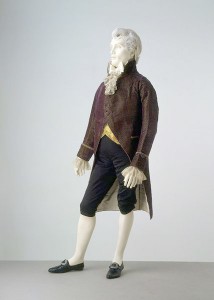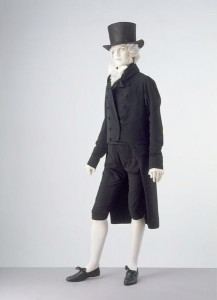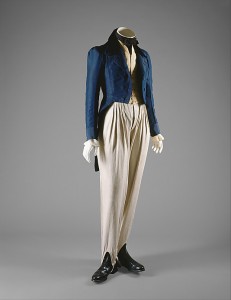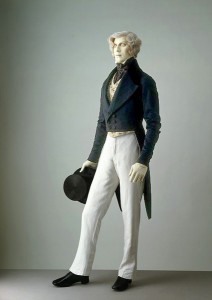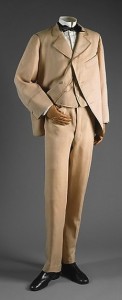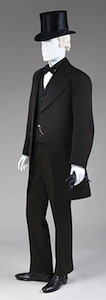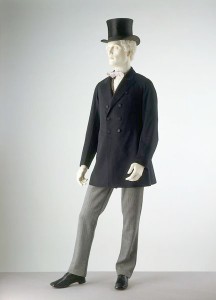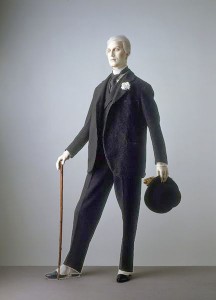“Court dress for men in the early 19th century retained many features of 18th-century dress. These included breeches, a waistcoat with short skirts, and a coat with curving back fronts. The dark, figured velvet continues a fashion in evening dress that began in the 1790s.”
“An ensemble made from black wool has been the uniform of the middle-class professional – doctor, lawyer, clergyman, academic, merchant, businessmen – since the late 16th century. This tradition continued through the 19th century and well into the 20th. The sombre colour of this suit befits the sober profession of its wearer, Thomas Coutts (1735-1822), the founder of Coutts Bank. The notched collar and cut-away front of the coat reflect early-19th-century fashions. On the other hand, the old-fashioned breeches are appropriate for Mr Coutts’s advanced age.” –V&A
“In the early years of the nineteenth century, there was a profound harmony between men’s and women’s silhouettes in dress. In the Empire style, the high waists and puffed chests of menswear match the silhouette of women’s clothing. In the 1830s, menswear accommodated the gigot sleeve of womenswear in its use of a new fullness at the sleeve cap. The typical men’s ensemble of tailcoat, waistcoat, and trousers prevailed by the 1820s and 1830s, as breeches were supplanted by long trousers.” –Metropolitan Museum of Art
“This coat is an example of men’s formal daywear of about 1850. The sleeves are long and tight, the collar is wide and the front opens very deep in order to show off the waistcoat. Although at this date the frock-coat is gaining popularity as formal daywear, the cut-away coat is still worn. This coat is reputed to have been worn by William Pierson Johnes, a linen merchant of New York City.”
Suit, Metropolitan Museum of Art
Suit, Metropolitan Museum of Art
“This is an excellent example of a double-breasted frock coat. Formal gentleman’s daywear of the later 19th century was usually of black or blue-black wool. The jacket, trousers and waistcoat that comprised the suit could be of one colour and were then known as ‘dittos’. Alternatively, a contrasting waistcoat and trousers were often worn to add colour and variety to the outfit. This style continued until the 20th century and became identified as the city business man’s suit of black coat, striped trousers and bowler hat (replacing the top hat).
This coat is said to have been worn by the donor’s father, Robert O’Brien Furlong, C.B., at his wedding in Dublin on 29 June 1871.”
“In the 1870s plain, checked and striped trousers were fashionable wear with morning coats. Stripes were particularly popular as they gave the impression of height, especially if they were cut fairly straight to the ankle like this pair which are strapped under the foot to keep the line. They were difficult to cut correctly as the stripes had to run straight down the leg and match at the seams and the best tailors employed specialist trouser cutters.
In this example the tailor has positioned the fabric on the bias to give sufficient room for the seat while cleverly matching the stripes in an inverted ‘V’ shape. The bias given to the seat seam was known as the ‘seat angle’. Two rising points cut in the top at the centre back accommodate the metal brace buttons which are stamped with the manufacturer’s name, E. Parkin & Sons, Sheffield. Less care has been taken to align the fabric here, probably because it was concealed under the coat.” –V&A
“The lounge suit became popular during the 1860s because of its easy comfort. It originated from the ‘lounging jacket’, which was cut to fit the waist without a waist seam by means of a long dart from under the arm to the waist. By the 1870s the jacket was worn with matching waistcoat and trousers and had become popular for informal wear. In the early 20th century it replaced the frock coat and the morning coat.
The owner of this lounge suit was Sir Max Beerbohm (1872-1956), the English essayist, caricaturist and master of a polished prose style.” – V&A
